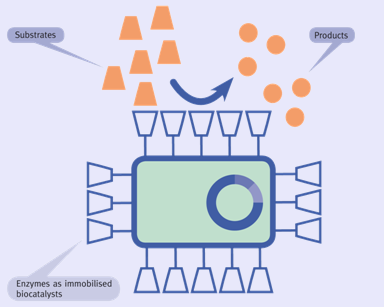|
BIOCATALYSIS
Cost-effective development and production of biocatalysts
The autodisplay technology enables the development of new biocatalysts and a cost-effective production of biocatalysts. With the immobilisation, using autodisplay, cost savings of up to 80% can be achieved over purified enzymes.
For example, the proteins on the surface can be used as efficient biocatalysts for the synthesis of steroids and rare sugars.

- Development of new biocatalysts
- Enzyme is immobilised on "bacterial beads"
- Easy production and purification
PRINCIPLE
Autodisplay whole-cell biocatalysts displaying a specific enzyme can be used for the production of fine chemicals. Due to the mobility of the anchoring domain in the outer-membrane, autodisplay enables the display of monomeric and even multimeric enzymes. Enzymes carrying prosthetic groups can also be displayed on the surface of E. coli. Furthermore, autodisplay also enables the surface display of different enzymes on the same cell. This allows interaction of enzymes and enhanced activity due to their close proximity.

A different application area is the use of autodisplay to create biodiversity. In this case, every E. coli cell carries a different variant of one protein/enzyme which can be screened in consideration of a specific characteristic to improve e.g. catalytic activity or stability.

SELECTED EXAMPLES
The spectrum of enzymes displayed at the cell surface by autodisplay spans a wide variety of different enzymes like hydrolases, esterases, nitrilases and electron transfer proteins.
Hydrolases: The β-lactamase hydrolase was the first example of the cell surface display of an active enzyme by autodisplay in E. coli. The cell integrity remained undisturbed, indicating a clear advantage of autodisplay for the surface expression of β-lactamase over other display systems in E. coli.
Esterases: Among the hydrolases, esterases represent a group of enzymes of great interest for biotechnological and industrial applications. They exhibit a broad natural variety of substrates and reaction types. Due to their diverse substrate specificities and their stereoselectivity, esterases have been successfully used in the synthesis of optically pure substances. The first esterase that was autodisplayed in an active form on the surface of E. coli was EstA from Burkholderia gladioli. The viability of E. coli cells displaying EstA was not reduced. This is a clear advantage of the heterologous surface display of esterases by autodisplay over other systems.
Nitrilase: The tetradecameric nitrilase from Alcaligenes faecalis was displayed on E. coli to give a whole cell biocatalyst for the enantioselective synthesis of (R)-mandelic acid from mandelonitrile. The whole cell biocatalyst converted up to 2.6 mM of (R)-mandelic acid under optimum conditions and by using chiral HPLC, the enantiomeric excess of the product was determined to be >99 %.
Bovine adrenodoxin: The ferredoxin from bovine adrenal cortex, termed adrenodoxin (Adx), plays an essential role in electron transport from adrenodoxin reductase (AdR) to mitochondrial cytochrome P450 enzymes, which are involved in the synthesis of steroid hormones. It was expressed on the surface of Escherichia coli as a monomeric fusion protein. Dimeric Adx molecules were formed spontaneously on the bacterial surface with high efficiencies. By adding purified adrenodoxin reductase and P450 CYP11A1, a whole cell biocatalyst system was obtained, which effectively synthesized pregnenolone from cholesterol.
|